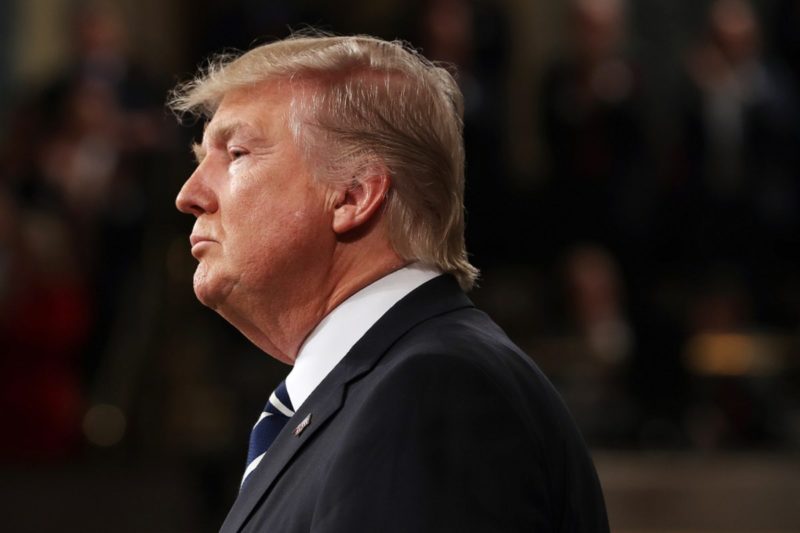What Trump’s Budget May Mean for Violence Against Women Programs
Though the president has only released a blueprint of his plans to fund the government, programs that help abuse survivors are on the cutting block.

Last week, the Trump administration released a budget blueprint for fiscal year 2018. Across the board, many programs for our communities’ most vulnerable residents were targeted for slashes by double-digit percentages, including programs to ensure food and nutrition aid for low-income people, as well as severe cuts in funding for health, education, and housing.
Initially, several sources reported that the Department of Justice’s Office on Violence Against Women would also experience drastic cuts. The office administers grants funded under the Violence Against Women Act (VAWA) and implements related programs such as technical support and training to community groups serving survivors, supporting indigenous and tribal communities affected by violence, addressing sexual assault on college campuses, and identifying and preventing gender bias. These reports of a reduced budget were followed by the release of the conservative Heritage Foundation’s “Blueprint For Balance,” which specifically called for eliminating the VAWA grants altogether (to the tune of $480 million) and influenced the Trump administration plan.
Since the president’s blueprint is only a top-line account of the budget proposal, it articulates a funding cut to the Department of Justice as a whole of only about 3.8 percent. The government blueprint doesn’t explicitly discuss VAWA, but makes clear that Department of Justice funding will be reallocated within the agency to focus more on efforts like border protection, immigration detention, and mitigating risks for so-called violence and crime in sanctuary jurisdictions (actually some of the safest cities nationwide).
The proposed reallocation of agency funds is cause for concern in a nation where women are targeted in acts of violence at alarming rates. The National Center for Injury Prevention and Control reports that each year women experience about 4.8 million intimate partner-related physical assaults and rapes. Results from the 2016 Campus Climate Survey by the Bureau of Justice Statistics found that one in five women experienced sexual assault during their college years.
Clearly, there’s a need to reduce this ongoing epidemic of violence, and the Trump budget threatens recent, hard-won progress to help more women. In 2013, the Violence Against Women Act was reauthorized to strengthen federal laws and dedicate funding for targeted programs to address violence among certain populations. Before 2013, Native American women, immigrant women, and LGBTQ Americans lacked proper protections under the law. Now, these groups have equal access and protection, which has been critical to addressing violence in a more comprehensive way. Since the initial enactment of VAWA in 1995, the Office on Violence Against Women has awarded more than $6 billion in grant funds.
The impact of potential VAWA cuts may also be compounded by similar budget reductions at government agencies that serve low-income people and women of color who experience domestic or intimate partner violence. Income and race are key factors in how likely a person will experience abuse from a loved one. While domestic violence happens to people of all backgrounds, the poorer the household, the higher the rate of domestic violence. Women in the lowest income bracket experience more than six times the rate of nonfatal intimate partner violence as compared to women in the highest income bracket. Black women women face higher rates of domestic violence than white women, and Native American women are victimized at a rate that exceeds those experienced by women of other races.
While domestic and intimate partner violence disproportionately affect low-income women and women of color, high rates of poverty, lack of education, limited job opportunities, language barriers, and fear of deportation can decrease the ability of a woman of color to find support services. This makes comprehensive, multipronged interventions to address violence against women critically important.
The Office on Violence Against Women has supported key programs in communities, yet additional programs across government agencies have also helped meet these needs. Programs within the Department of Health and Human Services, the Centers for Disease Control and Prevention, and Housing and Urban Development help survivors of violence with an array of support services. President Trump’s budget blueprint is calling for major cuts to these government agencies. Furthermore, organizations that tend to serve as the single health care access point for low-income women, such as Planned Parenthood, are key to ensuring access to domestic violence screenings and other health services for women and LGBTQ individuals. Planned Parenthood is also facing an overall budget cut as part of the proposed American Health Care Act, which would replace the Affordable Care Act.
The programs implemented under the Violence Against Women Act have made substantial contributions to not only helping women and LGBTQ survivors attain the services they need, but also in saving the government money. Analysis conducted by the University of North Carolina estimates that in the first six years after the Violence Against Women Act was passed, nearly $14.8 billion was saved in net averted social costs. These social costs include those related to accessing social and welfare services, housing, health care services, and more.
Cutting key agencies that support low-income women and women of color sends a clear signal of the values of President Trump and congressional Republicans. While earlier indications pointed to larger cuts for the Office on Violence Against Women, the reallocation of funds to support harsher punishment and stigmatization of immigrant communities is nothing short of disturbing. Additionally, cuts to housing, nutrition, health, and education will certainly affect survivors of violence and their families. The budget blueprint is a statement of President Trump’s values—values that rest on gutting essential services to low-income people, viewed as undeserving of the same quality of life that those in society with means enjoy.
